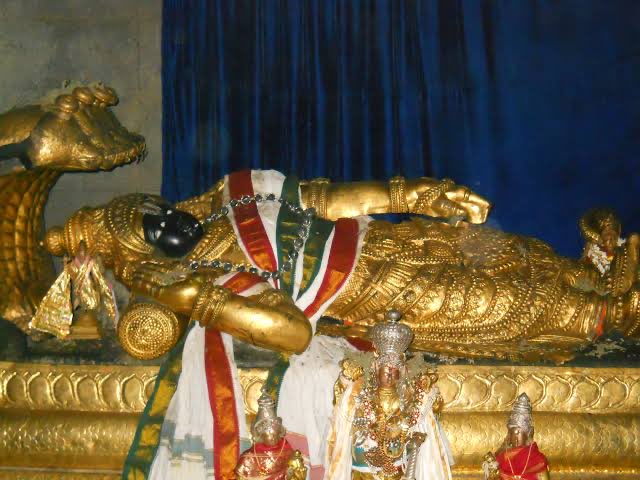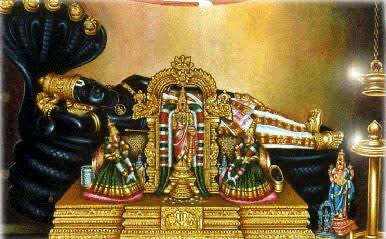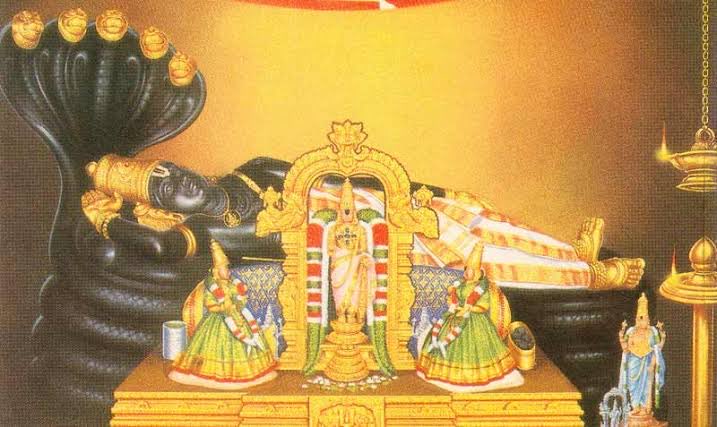I pray Ranganatha (maha Vishnu) to bless all our soldiers guarding borders and nationalist Tweeples with success & wealth. I pray for @narendramodi ji @AmitShah ji @myogiadityanath ji @nsitharaman ji and other leaders to be successful in taking this nation to new heights.
THE HISTORY of Sri Rangam traces back to the beginning of creation. Pleased by the penance of Brahma Visnu manifested Himself in the form Ranganatha for Brahma to worship.
Ranganatha appeared with His Deity chamber, or vimana. Lord with hi Viman was borne by Garuda.
Ranganatha appeared with His Deity chamber, or vimana. Lord with hi Viman was borne by Garuda.
Adisesha, had spread his hood over it. Vishvaksena walked in front clearing the way. The Sun and Moon were fanning the Deity. The celestial Musicians Narada and Tumburu followed singing His Glory. Rudra and other gods raised the glory chant"Jayghosh". The celestial maids danced.
There was a rain of flowers. The Lord informed Brahma that he had come as a Svayamvyakta on his own volition as a deity. He would appear likewise in eight places on earth Srirangam, Srimushnam, Venkatadri, Saligram, Naimisaranya, Totadri, Pushkara and Badri. Sri Ranga Vimana is
the first and the earliest of all these. The Lord directed Brahma to worship him strictly according to the procedure for worship laid down in the Agamas. Brahma carried the deity to Satyaloka and installed it on the banks of the river, Viraja. He appointed the Sun god to do the
daily pooja. After him, Vaivasvata Manu, performed worship. When his son Ikshvaku, became King of Ayodhya, he wanted to have it installed at Ayodhya. Ikshvaku performed penanace which lasted for many 100 years at the end of which he was permitted by Brahma to take it to Ayodhya.
It was this dynasty in which Lord was later to appear in His incarnation as Lord Ramacandra. Lord Ramacandra ruled in Ayodhya, in northern India, during the age known as Treta-yuga, millions of years ago. The pastimes of Lord Ramacandra are recounted in the epic Ramayana.
Ramachandra defeated the great demon Ravana, who had kidnapped the Lord’s wife, & placed Ravana’s brother Vibhisana on throne of Sri Lanka, Ravana’s former kingdom.
Vibhisana was a great devotee, Lord Ramacandra presented Him with Deity of Sri Ranganatha to worship in Sri Lanka,
Vibhisana was a great devotee, Lord Ramacandra presented Him with Deity of Sri Ranganatha to worship in Sri Lanka,
off the southeast coast of India. Rama, himself worshipped this deity and thereafter Deity came to be known as "Periya Perumal".
While traveling to Sri Lanka with Sri Ranganatha , Vibhisana stopped near the Kaveri River, at a holy place called Chandra Puskarini, where a Deity of
While traveling to Sri Lanka with Sri Ranganatha , Vibhisana stopped near the Kaveri River, at a holy place called Chandra Puskarini, where a Deity of
Ananta Sesha was worshiped. He gave to Ganesha who kept it in Sesha Peetam near the Chandrapuskarani and ran away. He returned after taking his bath and performed the Pooja and lo! when he tried to lift the Vimana, it would not move. It had got stuck up. Vibheeshana was overcome
with grief and shed tears. The Lord appeared before him and consoled him saying that he need not grieve as He had already decided to make the place His abode. He could come and worship him daily. It is said that Vibheeshana worships the Lord daily at midnight. Some say Vibhishana
goes to Srirangam every 12 years to worship the Lord. Dharma Varma, a king of region, had seen Lord Ranganatha in Ayodhya & had been previously praying for some time to be able to serve this deity in his own kingdom. Ranganatha blessed the king by promising to stay at SriRangam
Dharma Varma and his successors in Chola dynasty built a large temple around vimana of Lord Ranganatha and served Him. But after many generations the temple was covered in sand and gradually lost and forgotten. Then one day, temple histories say, a king of the Chola dynasty was
resting under a tree in the area when a parrot told him that Ranganatha was buried under sand. The parrot was again and again repeating a sloka.
Kaveree Viraja Seyam Vaikuntam Rangamandiram Sa Vasudevo Pangeshah Pratyaksham Paramam Padam | Vimanam Pranavakaram Vedasrungam
Kaveree Viraja Seyam Vaikuntam Rangamandiram Sa Vasudevo Pangeshah Pratyaksham Paramam Padam | Vimanam Pranavakaram Vedasrungam
Mahadhbhutham Srirangasayee Bhagavan Pranavarthaprakasakah
The river Kaveri is very same river Viraja that eternally flows in Vaikunta, Srirangam Temple is verily Vaikuntam itself, Abode of Vishnu where he sits in all splendour and majesty in company of Nityasuris
The river Kaveri is very same river Viraja that eternally flows in Vaikunta, Srirangam Temple is verily Vaikuntam itself, Abode of Vishnu where he sits in all splendour and majesty in company of Nityasuris
The Lord of Arangam, is none but Vasudeva, The Vimana is verily the external Paramapada itself. The Vimana is in form of Pranava (OM). The four towers are marvelously akin to four Vedas and Sri Rangasayee is expounding the import of Pranava. The king then excavated the temple &
restored all parts of the huge complex. Over the years to follow numerous Chola and Pandya kings, including Kulasekhara expanded and renovated temple. Great Vaisnava leaders Yamunacarya Ramanujacarya, & Sudarsanacarya all had important roles in further development of Sri Rangam.
The Vaishnava resurgent movement was spearheaded by Alvars who brought religion to heart of the people. They employed Tamil (the local language) as the medium of expression and composed the exuberant devotional songs – celebrated as the "Nalayira Divya Prabandham".
The shrines visited and glorified by them became holy places (Divya Desas). The temple at Srirangam and the Deity enshrined therein have been sung by all of them. A total of 247 hymns in the Nalayiram is found to be dedicated to the Lord of Srirangam as shown below
ānandarūpē nijabōdharūpē
brahmasvarūpē śrutimūrtirūpē
śaśāṅkarūpē ramaṇīyarūpē
śrīraṅgarūpē ramatāṁ manō mē 1
kāvēritīrē karuṇā vilōlē
mandāramūlē dhr̥ta cārukēlē
daityāntakālē:’khilalōkalīlē
śrīraṅgalīlē ramatāṁ manō mē 2 lakṣmīnivāsē jagatāṁ nivāsē
hr̥tpadmavāsē
brahmasvarūpē śrutimūrtirūpē
śaśāṅkarūpē ramaṇīyarūpē
śrīraṅgarūpē ramatāṁ manō mē 1
kāvēritīrē karuṇā vilōlē
mandāramūlē dhr̥ta cārukēlē
daityāntakālē:’khilalōkalīlē
śrīraṅgalīlē ramatāṁ manō mē 2 lakṣmīnivāsē jagatāṁ nivāsē
hr̥tpadmavāsē
ravibimbavāsē kr̥pānivāsē gunavrndavāsē
śrīraṅgavāsē ramatāṁ manō mē 3
brahmādivandyē jagadēkavandyē
mukundavandyē suranāthavandyē
vyāsādivandyē sanakādivandyē
śrīraṅgavandyē ramatāṁ manō mē 4 brahmādirājē garuḍādirājē
vaikuṇṭharājē surarājarājē trailōkyarājē khilalōkarājē
śrīraṅgavāsē ramatāṁ manō mē 3
brahmādivandyē jagadēkavandyē
mukundavandyē suranāthavandyē
vyāsādivandyē sanakādivandyē
śrīraṅgavandyē ramatāṁ manō mē 4 brahmādirājē garuḍādirājē
vaikuṇṭharājē surarājarājē trailōkyarājē khilalōkarājē
śrīraṅgarājē ramatāṁ manō mē 5
amōghamudrē paripūrṇanidrē
śrīyōganidrē sasamudranidrē
śritaikabhadrē jagadēkanidrē
śrīraṅgabhadrē ramatāṁ manō mē 6
sacitraśāyī bhujagēndraśāyī
nandāṅgaśāyī kamalāṅgaśāyī
kṣīrābdhiśāyī vaṭapatraśāyī
śrīraṅgaśāyī ramatāṁ manō mē 7
amōghamudrē paripūrṇanidrē
śrīyōganidrē sasamudranidrē
śritaikabhadrē jagadēkanidrē
śrīraṅgabhadrē ramatāṁ manō mē 6
sacitraśāyī bhujagēndraśāyī
nandāṅgaśāyī kamalāṅgaśāyī
kṣīrābdhiśāyī vaṭapatraśāyī
śrīraṅgaśāyī ramatāṁ manō mē 7
idaṁ hi raṅgaṁ tyajatāmihāṅgaṁ
punarnaśāṅgaṁ yadi śāṅgamēti
pāṇau rathāṅgaṁ caraṇēmbu
kāṅgaṁ yānē vihaṅgaṁ śayanē bhujaṅgam 8
raṅganāthāṣṭakaṁ puṇyaṁ prātarutthāya yaḥ paṭhēt
sarvānkāmānavāpnōti raṅgisāyujyamāpnuyāt
punarnaśāṅgaṁ yadi śāṅgamēti
pāṇau rathāṅgaṁ caraṇēmbu
kāṅgaṁ yānē vihaṅgaṁ śayanē bhujaṅgam 8
raṅganāthāṣṭakaṁ puṇyaṁ prātarutthāya yaḥ paṭhēt
sarvānkāmānavāpnōti raṅgisāyujyamāpnuyāt
आनन्दरूपे निजबोधरूपे
ब्रह्मस्वरूपे श्रुतिमूर्तिरूपे
शशाङ्करूपे रमणीयरूपे
श्रीरङ्गरूपे रमतां मनो मे १
कावेरितीरे करुणा विलोले
मन्दारमूले धृत चारुकेले
दैत्यान्तकालेऽखिललोकलीले
श्रीरङ्गलीले रमतां मनो मे २
लक्ष्मीनिवासे जगतां निवासे
हृत्पद्मवासे रविबिम्बवासे
कृपानिवासे गुणवृन्दवासे
ब्रह्मस्वरूपे श्रुतिमूर्तिरूपे
शशाङ्करूपे रमणीयरूपे
श्रीरङ्गरूपे रमतां मनो मे १
कावेरितीरे करुणा विलोले
मन्दारमूले धृत चारुकेले
दैत्यान्तकालेऽखिललोकलीले
श्रीरङ्गलीले रमतां मनो मे २
लक्ष्मीनिवासे जगतां निवासे
हृत्पद्मवासे रविबिम्बवासे
कृपानिवासे गुणवृन्दवासे
श्रीरङ्गवासे रमतां मनो मे ३
ब्रह्मादिवन्द्ये जगदेकवन्द्ये
मुकुन्दवन्द्ये सुरनाथवन्द्ये
व्यासादिवन्द्ये सनकादिवन्द्ये
श्रीरङ्गवन्द्ये रमतां मनो मे ४
ब्रह्मादिराजे गरुडादिराजे
वैकुण्ठराजे सुरराजराजे
त्रैलोक्यराजेऽखिललोकराजे
श्रीरङ्गराजे रमतां मनो मे ५
अमोघमुद्रे परिपूर्णनिद्रे
ब्रह्मादिवन्द्ये जगदेकवन्द्ये
मुकुन्दवन्द्ये सुरनाथवन्द्ये
व्यासादिवन्द्ये सनकादिवन्द्ये
श्रीरङ्गवन्द्ये रमतां मनो मे ४
ब्रह्मादिराजे गरुडादिराजे
वैकुण्ठराजे सुरराजराजे
त्रैलोक्यराजेऽखिललोकराजे
श्रीरङ्गराजे रमतां मनो मे ५
अमोघमुद्रे परिपूर्णनिद्रे
श्रीयोगनिद्रे ससमुद्रनिद्रे
श्रितैकभद्रे जगदेकनिद्रे
श्रीरङ्गभद्रे रमतां मनो मे ६
सचित्रशायी भुजगेन्द्रशायी
नन्दाङ्गशायी कमलाङ्गशायी
क्षीराब्धिशायी वटपत्रशायी
श्रीरङ्गशायी रमतां मनो मे ७
इदं हि रङ्गं त्यजतामिहाङ्गं
पुनर्नशाङ्गं यदि शाङ्गमेति
पाणौ रथाङ्गं चरणेम्बु
श्रितैकभद्रे जगदेकनिद्रे
श्रीरङ्गभद्रे रमतां मनो मे ६
सचित्रशायी भुजगेन्द्रशायी
नन्दाङ्गशायी कमलाङ्गशायी
क्षीराब्धिशायी वटपत्रशायी
श्रीरङ्गशायी रमतां मनो मे ७
इदं हि रङ्गं त्यजतामिहाङ्गं
पुनर्नशाङ्गं यदि शाङ्गमेति
पाणौ रथाङ्गं चरणेम्बु
काङ्गं याने विहङ्गं शयने भुजङ्गम् ८
रङ्गनाथाष्टकं पुण्यं प्रातरुत्थाय यः पठेत्
सर्वान्कामानवाप्नोति रङ्गिसायुज्यमाप्नुयात् @RajiIndustani @Jayashree_Ravis @SriRamya21 @AparBharat @ind_vignesh @Jaz_baatein @Mahesh10816 @MKG_II_0 @JumbuTweeple @v2l2b2 @rspchary
@OKarthik82
रङ्गनाथाष्टकं पुण्यं प्रातरुत्थाय यः पठेत्
सर्वान्कामानवाप्नोति रङ्गिसायुज्यमाप्नुयात् @RajiIndustani @Jayashree_Ravis @SriRamya21 @AparBharat @ind_vignesh @Jaz_baatein @Mahesh10816 @MKG_II_0 @JumbuTweeple @v2l2b2 @rspchary
@OKarthik82
@almightykarthik @anexcommie @Kishoreciyer1 @Achintiyah @super_sanatani @hindustaanihoon
@krithikasivasw @mayamadhava @kpkarthikbabu
@smita_muk @wataboutery @ethirajadasan
@swamisaranamm @NandiniVenkate3 @crprasadh @KumarSarangapa1
@MohanShobitha @sshyam_23 @Gopalee67
@krithikasivasw @mayamadhava @kpkarthikbabu
@smita_muk @wataboutery @ethirajadasan
@swamisaranamm @NandiniVenkate3 @crprasadh @KumarSarangapa1
@MohanShobitha @sshyam_23 @Gopalee67

 Read on Twitter
Read on Twitter




